
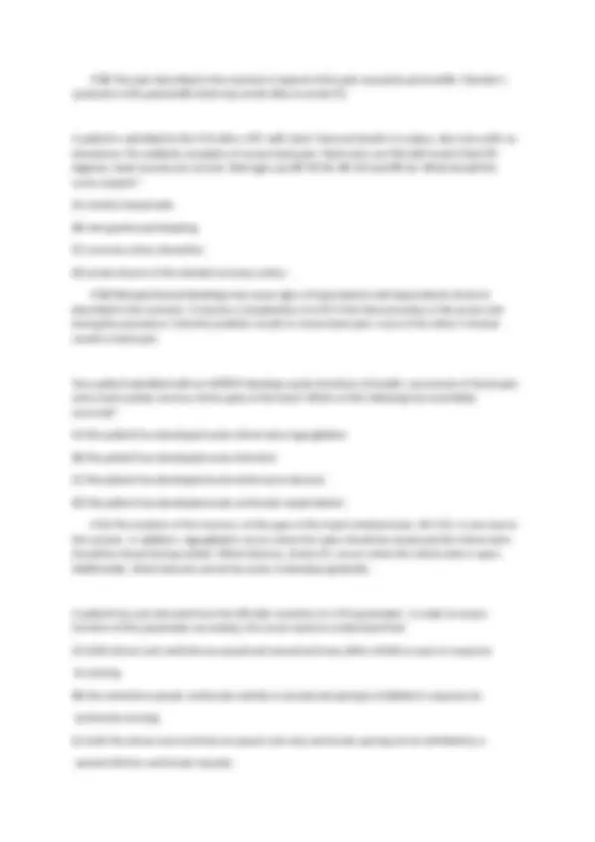
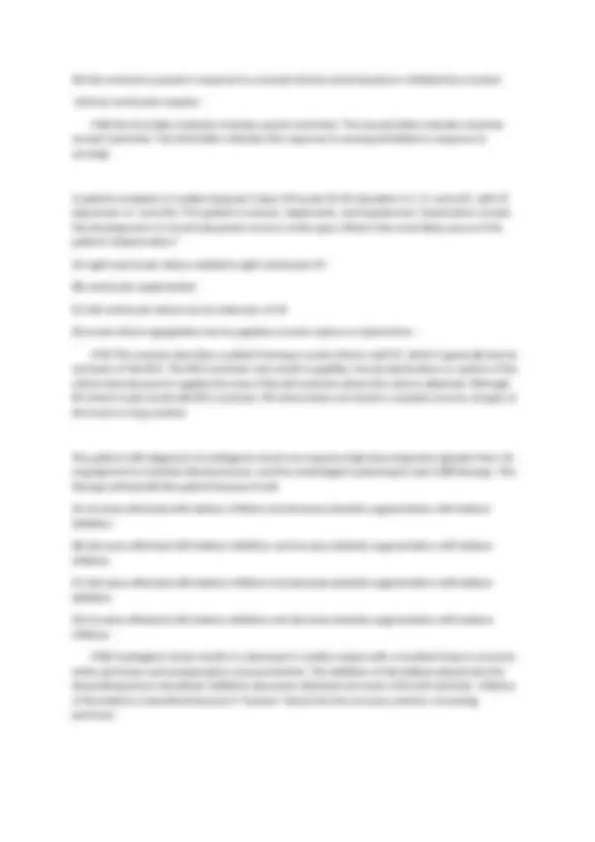
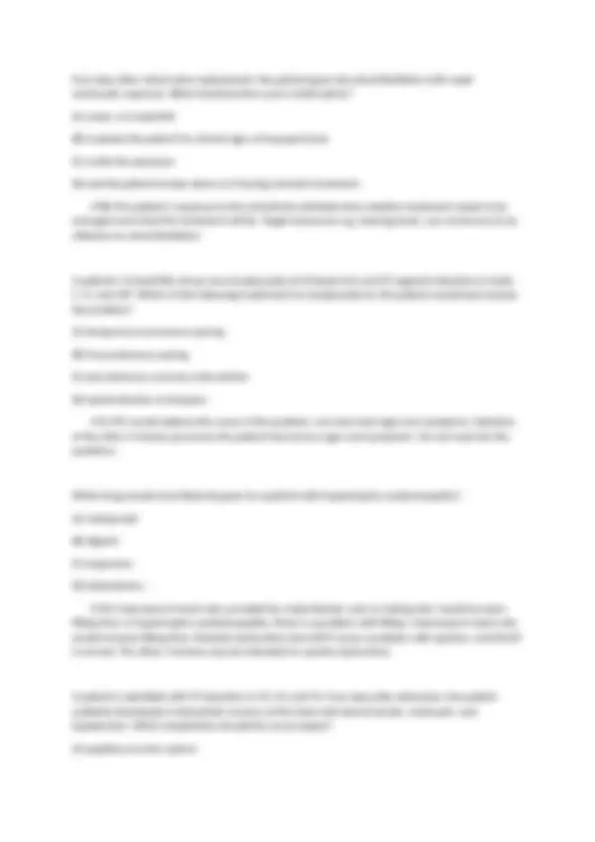
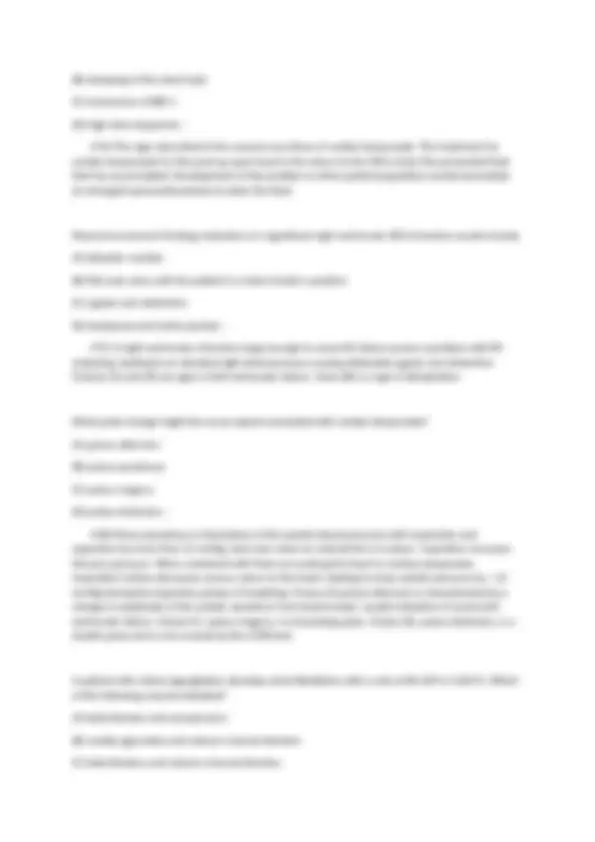
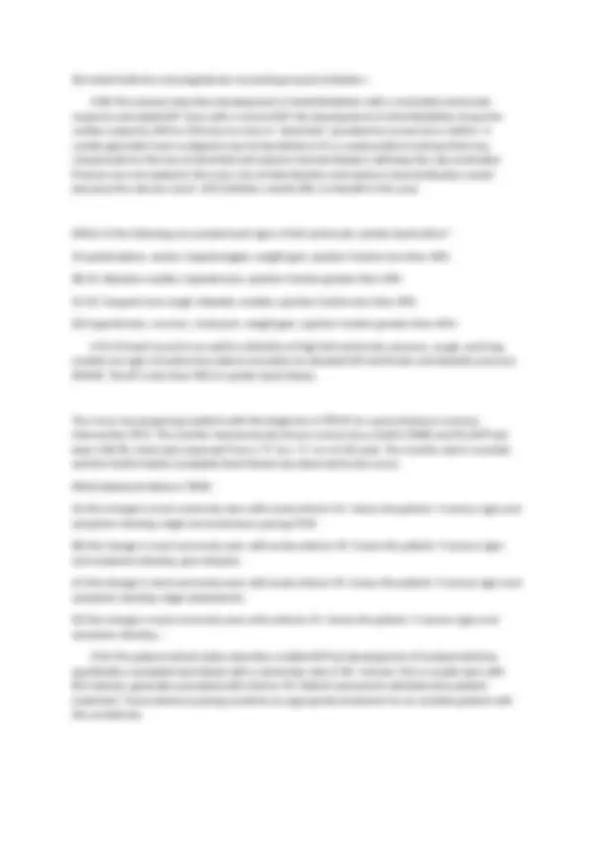
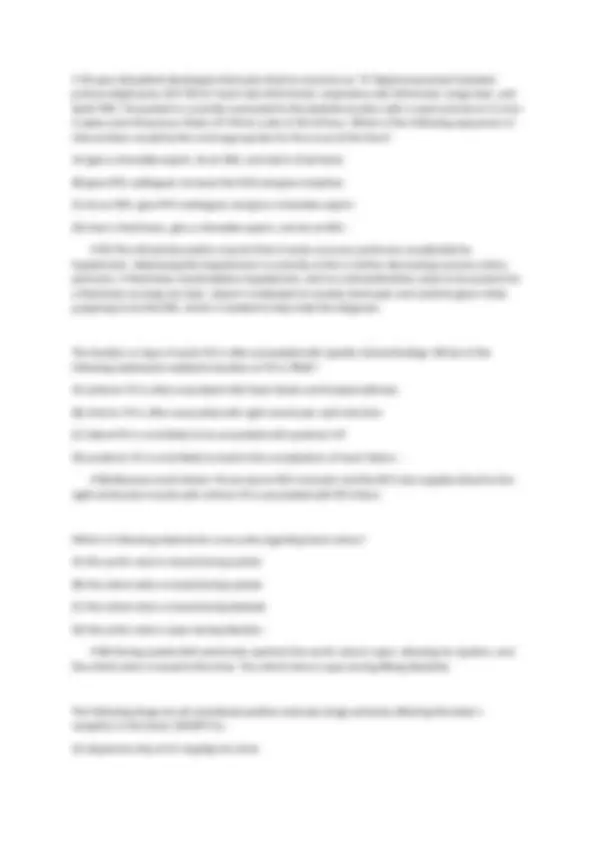
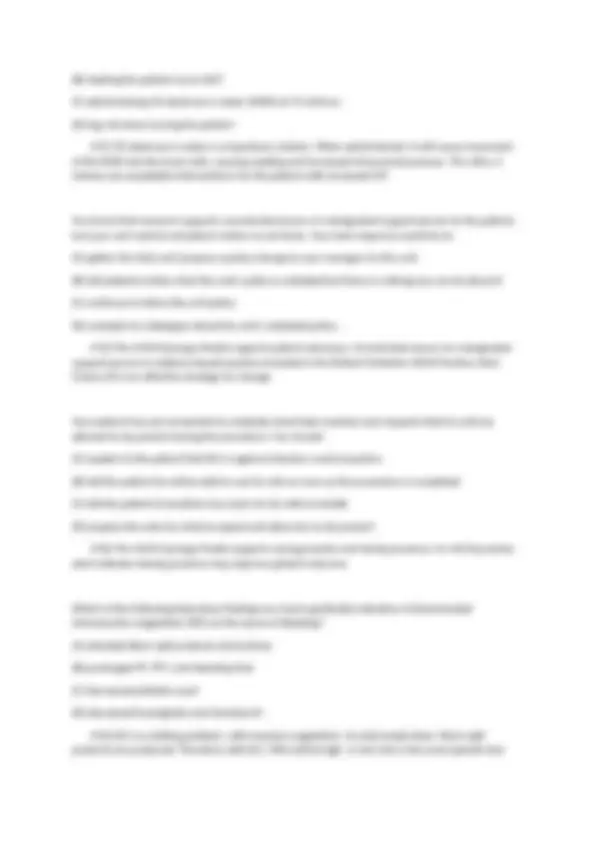
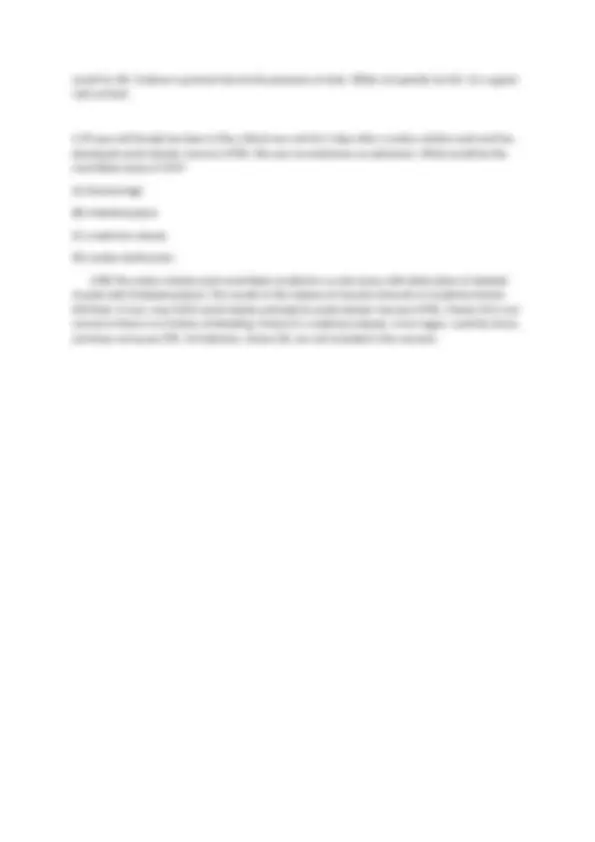


Study with the several resources on Docsity

Earn points by helping other students or get them with a premium plan


Prepare for your exams
Study with the several resources on Docsity

Earn points to download
Earn points by helping other students or get them with a premium plan
Community
Ask the community for help and clear up your study doubts
Discover the best universities in your country according to Docsity users
Free resources
Download our free guides on studying techniques, anxiety management strategies, and thesis advice from Docsity tutors
CCRN EXAM Questions & Exams 2024.
Typology: Exams
1 / 14

This page cannot be seen from the preview
Don't miss anything!









A 59 year old male is admitted complaining of chest pain and dyspnea. ST elevation and T wave inversion were seen on the EKG in V2,V3 and V4. IV thrombolytic therapy was started in ED. Indications of successful reperfusion would include all of the following except: (A) pain cessation (B) decrease in CK or troponin (C) reversal of ST segment elevation with return to baseline (D) short runs of ventricular tachycardia - ✔(B)Coronary artery reperfusion due to PCI or fibrinolysis results in an ELEVATION of creatinine kinase (CK) or troponin, not decrease. The theory is that the return of blood flow distal to the occlusion can result in 'reperfusion injury' of the muscle, elevating cardiac biomarkers. The other 3 choices are indicators of reperfusion: Pain cessation, reversal of ST segment elevation with return to baseline, short runs of ventricular tachycardia. Which of the following medication orders should the nurse question for the patient in question 1- reperfusion question-patient having an MI? (A) metoprolol (Lopressor) (B) aspirin (C) propranolol (Inderal) (D) heparin - ✔(C) The patient in the scenario is having an acute anterior wall MI. A beta blocker is beneficial for an acute MI as these agents decrease the work of the heart and increase the threshold for ventricular fibrillation. Propranolol, although a beta-andrenergic blocker like metoprolol, is NOT a cardioselective beta blocker. It affects beta receptors in heart muscle AND lung tissue. Therefore, it is more likely to cause bronchoconstriction than a cardioselective beta blocker. The other 3- cardioselective beta blocker, antiplatelet, and anticoagulation-are indicated in an acute MI. If heart block develops while caring for the patient in question 1 (pt with an MI who went through reperfusion from PCI or fibrinolytic therapy), which of the following would it most likely be? (A) sinoatrial block (B) second degree, Type I (C) second degree, Type II (D) third degree, complete -
✔(C) The patient is having an acute anterior MI, which is generally due to LAD occlusion. The LAD supplies the HIS bundle, which could result in a second-degree, type II heart block. The other 3 types are due to SA node or AV node ischemia, which generally occur with an RCA occlusion — interior wall MI. Appropriate drug therapy for dilated cardiomyopathy is aimed toward: (A) decreasing contractility and decreasing preload and afterload (B) decreasing contractility and increasing preload and afterload (C) increasing contractility and increasing both preload and afterload (D) increasing contractility and decreasing both preload and afterload - ✔(D) Dilated cardiomyopathy is likely to result in systolic dysfunction, which decreases contractility, causes compensatory arterial constriction , and results in a higher left ventricular preload. To treat this, therapy is aimed at increasing contractility, decreasing afterload (arterial constriction), and decreasing preload that is too high.😃 An 18 year old is admitted with a history of syncopal episode at the mall and has a history of an eating disorder. The nurse notes a prolonged QT on the 12-lead EKG and anticipates a reduction in an electrolyte to be the cause. Which of the following is LEAST likely to cause this patient's problems? (A) sodium (B) magnesium (C) potassium (D) calcium - ✔(A) Abnormal sodium does NOT cause QT prolongation. In contrast, a low magnesium, potassium, or calcium, may cause QT prolongation and may result in TORSADES DE POINTES ventricular tachycardia and, if self-limiting, transient syncopal episodes. On the third day after admission for acute MI, a 67 year old male complains of chest pain and develops a fever. The pain is worse with deep inspiration and is relieved when he leans forward. There are nonspecific ST changes in the precordial leads of the EKG. The nurse anticipates that the patient will most likely need treatment for: (A) thoracic aneurysm (B) Dressler's syndrome (C) reinfarction (D) pleuritis -
(D) the ventricle is paced in response to a sensed intrinsic atrial impulse or inhibited by a sensed intrinsic ventricular impulse. - ✔(B) the first letter indicates chamber paced (ventricle). The second letter indicates chamber sensed (ventricle). The third letter indicates the response to sensing (inhibited in response to sensing). A patient complains of sudden dyspnea 5 days S/P acute MI (ST elevation in II, III, and aVF, with ST depression in I and aVL). The patient is anxious, diaphoretic, and hypotensive. Examination reveals the development of a loud holosystolic murmur at the apex. What is the most likely cause of this patient's deterioration? (A) right ventricular failure related to right ventricular MI (B) ventricular septal defect (C) left ventricular failure due to extension of MI (D) acute mitral regurgitation due to papillary muscle rupture or dysfunction - ✔(D) The scenario describes a patient having an acute inferior wall MI, which is generally due to occlusion of the RCA. The RCA occlusion may result in papillary muscle dysfunction or rupture of the mitral valve because it supplies the area of the left ventricle where this valve is attached. Although RV infarct could result with RCA occlusion, RV infarct does not result in a systolic murmur at apex of the heart or lung crackles. The patient with diagnosis of cardiogenic shock now requires high dose dopamine (greater than 10 mcg/kg/min) to maintain blood pressure, and the cardiologist is planning to start IABP therapy. This therapy will benefit the patient because it will: (A) increase afterload with balloon inflation and decrease diastolic augmentation with balloon deflation. (B) decrease afterload with balloon deflation and increase diastolic augmentation with balloon inflation. (C) decrease afterload with balloon inflation and decrease diastolic augmentation with balloon deflation (D) increase afterload with balloon deflation and decrease diastolic augmentation with balloon inflation. - ✔(B) Cardiogenic shock results in a decrease in cardiac output with a resultant drop in coronary artery perfusion and compensatory vasoconstriction. The deflation of the balloon placed into the descending aorta is beneficial. Deflation decreases afterload and work of the left ventricle. Inflation of the balloon is beneficial because it "boluses" blood into the coronary arteries, increasing perfusion.
Four days after mitral valve replacement, the patient goes into atrial fibrillation with rapid ventricular response. What should be the nurse's initial action? (A) order a 12 lead EKG (B) evaluate the patient for clinical signs of hypoperfusion (C) notify the physician (D) ask the patient to bear down as if having a bowel movement - ✔(B) The patient's response to the arrhythmia will determine whether treatment needs to be emergent and what the treatment will be. Vagal maneuvers e.g. bearing down, are not known to be effective for atrial fibrillation. A patient's 12 lead EKG shows sinus bradycardia at 44 beats/min and ST segment elevation in leads II, III, and aVF. Which of the following treatments for bradycardia for this patient would best resolve the problem? (A) temporary transvenous pacing (B) transcutaneous pacing (C) percutaneous coronary intervention (D) administration of atropine - ✔(C) PCI would address the cause of the problem, not only treat signs and symptoms. Selection of the other 3 choices presumes the patient had serious signs and symptoms. Do not read into the questions. Which drug would most likely be given to a patient with hypertrophic cardiomyopathy? (A) metoprolol (B) digoxin (C) dopamine (D) dobutamine - ✔(A) A decrease in heart rate, provided by a beta blocker such as metoprolol, would increase filling time. In hypertrophic cardiomyopathy, there is a problem with filling. A decrease in heart rate would increase filling time. Diastolic dysfunction does NOT cause a problem with ejection, and the EF is normal. The other 3 choices may be indicated for systolic dysfunction. A patient is admitted with ST elevation in V2, V3, and V4. Four days after admission, the patient suddenly developed a holosystolic murmur at the lower left sternal border, chest pain, and hypotension. What complication should the nurse expect? (A) papillary muscle rupture
hypertrophy pattern, chest radiograph showed normal heart size, pulmonary vascular congestion, and echocardiogram showed EF of 55%. Which of the following should be avoided in this patient's treatment plan? (A) calcium channel blocker (B) digoxin (C) low-dose diuretics (D) oxygen - ✔(B) The patient presents with signs of heart failure due to diastolic dysfunction (hypertension, left ventricular hypertrophy, EF > 40%). These patients have a problem with FILLING, not ejecting. Digoxin, a positive inotrope, may increase wall stress and worsen filling of the left ventricle.😳 Mrs. Jones has heart failure. 😩 Despite optimal therapy, she gets short of breath when she gets up to walk to the bathroom. Which of the following is the patient experiencing regarding heart failure? (A) NYHA Class I heart failure, may benefit from an ICD (B) NYHA Class II heart failure, may benefit from an ICD (C) NYHA Class III heart failure, may benefit from an ICD (D) heart failure cannot be classified, further information is needed - ✔(C) The patient has symptoms with minimal activity, which describes NYHA Class III. This would qualify her for an ICD. When the above patient, Mrs. Jones, has an exacerbation of her heart failure (Class III), she develops jugular venous distention (JVD), peripheral edema, and abdominal discomfort. These are clinical signs specific to: (A) acute left ventricular failure (B) chronic right ventricular failure (C) acute right ventricular failure (D) chronic dehydration - ✔(B) The signs described are those of chronic right-sided heart failure. Acute right ventricular failure may result in JVD but not peripheral edema or abdominal discomfort (which is due to liver engorgement). The nurse managing a post-op CABG patient assesses a sudden drop in B/P, distended neck veins, muffled heart tones, minimal chest tube of output, and a systolic pressure that fluctuates with breathing pattern. The patient most likely needs: (A) emergent return to the OR
(B) clamping of the chest tube (C) transfusion of RBC's (D) high-dose dopamine - ✔(A) The signs described in the scenario are those of cardiac tamponade. The treatment for cardiac tamponade for the post-op open heart is the return to the OR to drain the pericardial fluid that has accumulated. Development of the problem in other patient population would necessitate an emergent pericardiocentesis to drain the fluid. Physical assessment findings indicative of a significant right ventricular (RV) infarction would include: (A) bibasilar crackles (B) flat neck veins with the patient in a Semi-Fowler's position (C) jugular vein distention (D) tachypnea and frothy sputum - ✔(C) A right ventricular infarction large enough to cause RV failure causes a problem with RV emptying, leading to an elevated right atrial pressure causing distended jugular vein distention. Choices (A) and (D) are signs of left ventricular failure. Voice (B) is a sign of dehydration What pulse change might the nurse expect associated with cardiac tamponade? (A) pulsus alternans (B) pulsus paradoxus (C) pulsus magnus (D) pulsus bisferiens - ✔(B) Pulsus paradoxus is fluctuation of the systolic blood pressure with inspiration and expiration by more than 12 mmHg, best seen when an arterial line is in place. Inspiration increases thoracic pressure. When combined with fluid surrounding the heart in cardiac tamponade, inspiration further decreases venous return to the heart, leading to drop systolic pressure by > 12 mmHg during the inspiratory phase of breathing. Choice (A) pulsus alternans is characterized by a change in amplitude of the systolic waveform from beat to beat, usually indicative of severe left ventricular failure. Choice (C), pulsus magnus, is a bounding pulse. Choice (D), pulsus bisferiens, is a double pulse and is not covered by the CCRN test. A patient with mitral regurgitation develops atrial fibrillation with a rate of 88, B/P of 118/75. Which of the following may be indicated? (A) beta blockers and vasopressors (B) cardiac glycosides and calcium-channel blockers (C) beta blockers and calcium-channel blockers
A 58 year old patient developed chest pain that he scored as an "8" Rapid assessment included profuse diaphoresis, B/P 78/52, heart rate 104/minute, respiratory rate 20/minute, lungs clear, and SpO2 98%. The patient is currently connected to the bedside monitor with a nasal cannula at 2 L/min in place and intravenous fluids, 0.9 NS at a rate of 10 ml/hour. Which of the following sequences of interventions would be the most appropriate for the nurse at this time? (A) give a chewable aspirin, do an EKG, and start a fluid bolus (B) give NTG sublingual, increase the FiO2 and give morphine (C) do an EKG, give NTG sublingual, and give a chewable aspirin (D) start a fluid bolus, give a chewable aspirin, and do an EKG - ✔(D) The clinical description may be that of acute coronary syndrome complicated by hypotension. Addressing the hypotension is a priority as this is further decreasing coronary artery perfusion. A fluid bolus would address hypotension, and no contraindications seem to be present for a fluid bolus as lungs are clear. Aspirin is indicated for acutely chest pain and could be given while preparing to do the EKG, which is needed to help make the diagnosis. The location or type of acute MI is often associated with specific clinical findings. Which of the following statements related to location of MI is TRUE? (A) anterior MI is often associated with heart blocks and bradyarrythmias (B) inferior MI is often associated with right ventricular wall infarction (C) lateral MI is most likely to be associated with posterior MI (D) posterior MI is most likely to lead to the complication of heart failure - ✔(B) Because most inferior MI are due to RCA occlusion and the RCA also supplies blood to the right ventricular muscle wall, inferior MI is associated with RV infarct. Which of following statements is accurate regarding heart valves? (A) the aortic valve is closed during systole (B) the mitral valve is closed during systole (C) the mitral valve is closed during diastole (D) the aortic valve is open during diastole - ✔(B) During systole (left ventricular ejection) the aortic valve is open, allowing for ejection, and the mitral valve is closed at this time. The mitral valve is open during filling (diastole). The following drugs are all considered positive inotropic drugs primarily affecting the beta- reception in the heart, EXCEPT for: (A) dopamine drip at 12 mcg/kg/min dose
(B) dopamine drip at 5 mcg/kg/min dose (C) dobutamine drip at 7 mcg/kg/min dose (D) milrinone at 7 mcg/kg/min dose - ✔(A) At high doses (> 10 mcg/kg/min), dopamine stimulates alpha receptors in arteries and causes vasoconstriction. The other 3 drugs/doses affect mainly beta-1 receptors in the heart, producing a positive inotropic effect. Which of the following is associated with mitral regurgitation? (A) Systolic murmur, sinus bradycardia (B) Diastolic murmur, heart failure (C) Systolic murmur, inferior wall myocardial infarction (D) Diastolic murmur, complete heart block - ✔(C) Inferior wall MI may result in ischemia and dysfunction (regurgitation) of the mitral valve. The mitral valve is closed during systole (left ventricular ejection). A murmur is produced when the mitral valve is not fully closed during systole. Nitrate therapy is indicated for the treatment of unstable angina and acute heart failure because it: (A) decreases preload and increases myocardial O2 demand (B) increases preload and increases myocardial O2 demand (C) increases preload and decreases myocardial O2 demand (D) decreases preload and decreases myocardial O2 demand - ✔(D) Nitrates cause venodilation, which results in a decrease in venous return to the heart (left ventricular preload reduction). The decrease in preload decreases the work of the left ventricle and myocardial oxygen demand. All of the following support the diagnosis of cardiac tamponade EXCEPT: (A) widening pulse pressure (B) equalization of right and left heart pressures (C) pulsus paradoxus (D) enlarged heart on CXR - ✔The pulse pressure NARROWS with cardiac tamponade. The other 3 choices ARE seen with cardiac tamponade.
(B) feeding the patient via an NGT (C) administering 5% dextrose in water (D5W) at 75 ml/hour (D) log roll when turning the patient - ✔(C) 5% dextrose in water is a hypotonic solution. When administered, it will cause movement of the D5W into the brain cells, causing swelling and increased intracranial pressure. The other 3 choices are acceptable interventions for the patient with increased ICP. You know that research supports unrestricted access of a designated support person to the patient, but your unit restricts all patient visitors to set times. Your best response would be to: (A) gather the facts and propose a policy change to your manager for the unit (B) tell patients/visitors that the unit's policy is outdated but there is nothing you can do about it (C) continue to follow the unit policy (D) complain to colleagues about the unit's outdated policy. - ✔(A) The AACN Synergy Model supports patient advocacy. Unrestricted access of a designated support person is evidence-based practice included in the Patient Visitation AACN Practice Alert. Choice (A) is an effective strategy for change. Your patient has just consented to a bedside chest tube insertion and requests that his wife be allowed to be present during the procedure. You should: (A) explain to the patient that this is against infection control practice (B) tell the patient he will be able to see his wife as soon as the procedure is completed (C) tell the patient it would be too much for his wife to handle (D) prepare the wife for what to expect and allow her to be present - ✔(D) The AACN Synergy Model supports caring practice and family presence. An AACN practice alert indicates family presence may improve patient outcome. Which of the following laboratory findings are most specifically indicative of disseminated intravascular coagulation (DIC) as the cause of bleeding? (A) elevated fibrin split products and d-dimer (B) prolonged PT, PTT, and bleeding time (C) decreased platelet count (D) decreased hemoglobin and hematocrit - ✔(A) DIC is a clotting problem, with massive coagulation. As clots break down, fibrin split products are produced. Therefore with DIC, FSPs will be high. In fact, this is the most specific test
result for DIC. D-dimer is present due to the presence of clots. While not specific for DIC, it is a good rule-out test. A 29 year old female has been in the critical care unit for 2 days after a motor vehicle crash and has developed acute tubular necrosis (ATN). She was normotensive on admission. What would be the most likely cause of ATN? (A) hemorrhage (B) rhabdomyolysis (C) creatinine release (D) cardiac dysthymias - ✔(B) The motor vehicle crash most likely resulted in a crash injury with destruction of skeletal muscle cells (rhabdomyolysis). This results in the release of massive amounts of creatinine kinase (CK) that, in turn, may CLOG renal tubules and lead to acute tubular necrosis (ATN). Choice (A) is not correct as there is no history of bleeding. Choice (C), creatinine release, is too vague, could be minor, and does not cause ATN. Arrhythmias, choice (D), are not included in the scenario.